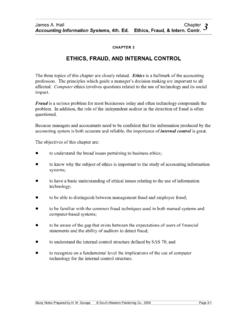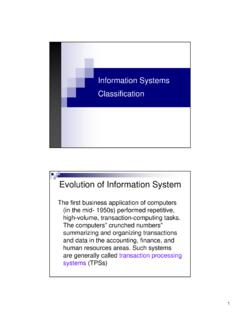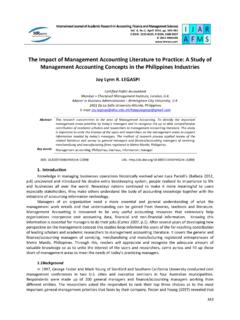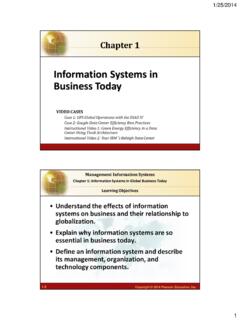Transcription of Executive Information Systems William B. Creps Daniel E. O ...
1 Executive Information Systems William B. Creps Daniel E. O'Leary 1994 1 ~ Table of Contents 1. Introduction "What Is an Executive Information system ? 1 The Purpose ofThis Bulletin 1 The Scope ofThis Bulletin 1 The Structure ofThis Bulletin 2 2. Elements ofan Executive Information system 3 Database Interface Features 3 Presentation Features 4 Other Decision-Support Activities 5 Application Development Features 5 Typical Installation Configurations 6 3. Benefits ofan Executive Information system 7 A n Example: Phillips 66 Company 7 ~ Reasons for Implementation 8 4.
2 Limitations of an Executive Information system 10 Security 10 Financial Data Interrelationships 11 Executive Information 11 Drill Down and Other Analysis 11 Limited Integrated View 11 Executive Involvement 11 Network Support 12 Costs 12 5. Business Processes Affected by an Executive Information system 13 Data Organization and Access 13 Management Reporting system 13 Corporate Software Development 14 Software and Hardware Support 14 Computer system Downsizing and Rightsizing 14 6. Conclusion 15 References 11 Q Chapter 1.
3 Introduction What Is an Executive Information system ? An Executive Information system (EIS) provides key Information , gathered from both internal and external sources, to senior executives and managers. It accom plishes the multiple purposes of supporting decision making, communicating Information , and providing awareness. EISs typically present summarized Information , but allow the user to drill down to more detailed Information . EISs should also present Information in a user friendly format to facilitate easy analysis, and employ graphical user interfaces (GUIs), which can be tailored to individual preferences.
4 Often, EISs are inte grated with spreadsheet, word processing, and other decision-support software. A key ability of an EIS is easily communicating the comments and conclu sions of executives to others. As a result, EISs are typically supported by an electronic mail (e-mail) system . Installing an EIS often forces a business to restructure the Information it uses to make decisions and 'the process by which it collects Information . For example, if an EIS is designed for the company's chief Executive officer (CEO), then all those reporting to the CEO will want the same Information ; likewise, if it is designed for vice presidents, then those reporting to them will want that same Information .
5 The EIS facilitates a shared view of the company that is focused on the issues of interest and importance to its executives, in contrast to traditional accounting Systems that are focused on day-to-day financial transactions. EISs have been known by many names over the years. Initially, decision support Systems (DSSs) were developed with the same aim of current EISs. In addition, EISs are known in some circles as Executive -support Systems (ESSs). No matter what they are called, the number of EIS installations continues to grow.
6 According to industry estimates, revenues from the sales of commercial EIS soft ware have grown at an average rate of 30 percent per year for the past five years. Projections indicate future growth at or above that rate.! The Purpose of This Bulletin The purpose of this technology bulletin is to report on the capabilities and fea tures of today's EISs. Specifically, this bulletin identifies ways EISs can benefit businesses and how such Systems affect both internal and external accountants. It also reviews key business processes that are affected by implementing an EIS.
7 The Scope of This Bulletin This bulletin primarily discusses mainframe-based EISs, since these represent the majority of the EISs in use today. However, where pertinent, it also discusses the features of EISs that are on networks or based on personal computers (PCs), which are gaining in popularity. This bulletin is based on a survey of current EIS research done in academic and corporate environments. And, where appropri ate, it provides examples of implemented EISs based on articles published in trade publications. This bulletin does not include detailed Information about EIS implemen tation; such Information would be found in a publication such as a practice aid.
8 It also does not evaluate specific EIS software products or computer hardware platforms. EXECUTIYE b,,'FORlWATION Systems The Structure of This Bulletin Following the introduction in chapter 1, this bulletin proceeds as follows: Chapter 2 discusses the elements of an EIS, including its data extraction, decision-support, and communications capabilities. Chapter 3 presents some of the benefits of an EIS, including an example of a successful large-scale EIS. Chapter 4 investigates some of the limitations of an EIS.
9 Chapter 5 analyzes the business processes that are affected by the devel opment and implementation of an EIS. Chapter 6 summarizes the main points of this bulletin. 1 Chapter 2. Elements ofan Executive Information system Database Interface Features r An EIS is not a specific technology. Rather, it is a system of software that uses other technologies such as GUIs, personal computers, relational databases, and network communications to display key Information to management. Thus, an EIS implementation would normally include database interface and presenta tion features.
10 It would also include access to other decision-support tools, such as spreadsheets, and contain application development features such as fourth generation programming languages. Available Databases EISs normally access Information from virtually all of a company's internal data bases, including production, financial, customer, and vendor Information . In addition, EISs can access external databases that provide executives with industry Information and business news EISs with access to external news databases must effectively filter huge amounts of data to be effective.










